- Lesson One: The Number One
- ... in Geometry
- ... in Nature
- ... in Culture
- "Uroboros" (related artwork by the author)
- "Creation" (related artwork by the author)
- Lesson Two: The Square Root of Two
- ... in Geometry
- ... in Nature, Part 1
- ... in Nature, Part 2
- ... in Culture, Part 1
- ... in Culture, Part 2
- "Duality" (related artwork by the author)
- Lesson Three: The Square Root of Three
- ... in Geometry
- ... in Nature
- ... in Culture
- "Vesica" (related artwork by the author)
- Lesson Four: Phi, or the Golden Proportion
- ... Intro, Part 2
- ... Intro, Part 3
- ... in Geometry
- ... in Nature
- ... in Nature, Part 2
- ... in Culture
- "The Flower of Phi" (related artwork by the author)
- Lesson Five: The Five Perfect Solids
- ... Intro, Part 2
- ... The Tetrahedron
- ... The Octahedron
- ... The Cube
- ... The Icosahedron
- ... The Dodecahedron
There are literally hundreds of examples of humankind's use of the Golden Proportion in its artworks and architecture, and here we will show a few of them. These examples have been chosen because it is felt that they prove beyond any doubt that their creators very consciously intended their creations to be wholly based on this beautiful proportion.
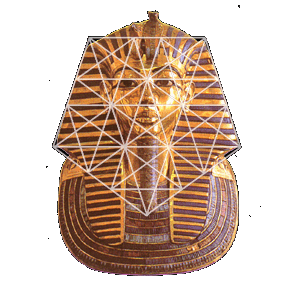 scanned image of egyptian headpiece reworked by A. O'Connor for Nature's Word using Adobe Photoshop 5.0. Taken From: Alberto Siliotti's book Egypt; Splendors of an Ancient Civilization, Thames and Hudsonl, 1994
scanned image of egyptian headpiece reworked by A. O'Connor for Nature's Word using Adobe Photoshop 5.0. Taken From: Alberto Siliotti's book Egypt; Splendors of an Ancient Civilization, Thames and Hudsonl, 1994We begin with this most famous example, the head piece of ancient Egypt's young pharoah Tutankhamun, which was created of solid gold to encase his mummy c. 1300 BC. Although many have seen this rather popularized image, its obvious pentagonal symmetry is rarely presented or mentioned.
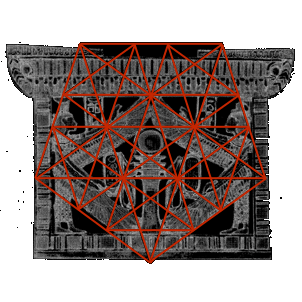 scanned image of egyptian jewelry reworked by A. O'Connor for Nature's Word using Adobe Photoshop 5.0. Taken From: Michael Schneider's book A Beginner's Guide to Constructing the Universe, HarperPerennial, 1995
scanned image of egyptian jewelry reworked by A. O'Connor for Nature's Word using Adobe Photoshop 5.0. Taken From: Michael Schneider's book A Beginner's Guide to Constructing the Universe, HarperPerennial, 1995Here we find two pieces of jewelry, known as pectorals, also created by the ancient Egyptian culture to adorn a pharoah or queens's mummy. Although differing in specific symbolism, both were considered to be powerful amulets to protect the dead ruler's soul and assist them in their journey through the afterlife.
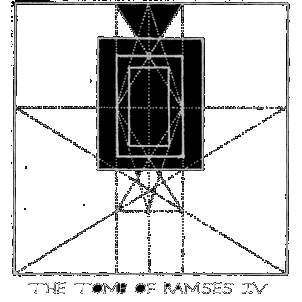 Taken From: Nigel Pennick's book Sacred Geometry, Harper & Row, 1980
Taken From: Nigel Pennick's book Sacred Geometry, Harper & Row, 1980Egyptian architecture made extensive use of the Phi proportion, and especially so in regards to their tombs. This diagram is a top view of the tomb of Ramses IV. The three rectangles near the center of the room represent the outlines of the dias upon which the pharoah's sarcophagus rests, with the inner most rectangle outlineing the sacrophagus itself. The walls of the room form a perfect square (representing unity), and the various dotted lines divide the length of the walls at the Golden Section. After these initial Golden Section lines are determined, the points at which they cross are used to determine transversals. It is the recursive nature of the Phi proportion that the points at which the transversals cross are exponential numbers of the intial phi division (one divided by phi to the second power, third power, etc.)
It should be noted at this point that all of the above examples relate to the issue of creating amulets (either in gold or in the very form of the tomb itself) for the protetion of a ruler in the afterlife. Although the Egyptians used the Golden Proportion in much of their artwork and architecture, its use was particularly stressed in regards to the afterlife due to the regenerative aspect of the number.
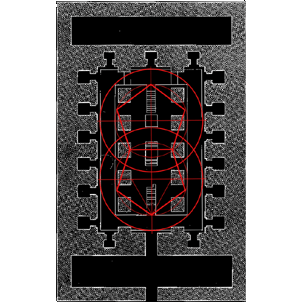 Taken From: Robert Lawlor's book Sacred Geometry; Philosophy and Practice, Thames and Hudson, 1982
Taken From: Robert Lawlor's book Sacred Geometry; Philosophy and Practice, Thames and Hudson, 1982Another example of Egyptian architecture shows us a more complex usage of pentagonal symmetry. This time, however, the building depicted is not a tomb, but instead is believed to have been a temple used for initiation ceremonies. It is known as the Osirion, and is located completely below ground level. the rectangle that is defined by the outer points of the two abutted pentagons is in fact a platform, with stairs leading up to it at the far ends. The small node-like chambers that radiate from the central chamber are also located off the ground, with their floors being at the same level as the central platform. It is believed that the lower areas of the room were filled with water, turning the central platform into an island of sorts, and that the small node-like chambers were used as meditation chambers by initiates.
The use of the phi proportion in this instance is no suprise either, when it is considered that the Egyptians believed that an initiation into the temple was an effectivly a rebirth for the initiate to a new life - the profane individual had died, and the spiritual person was born out of the ashes of his/her death. The regenerative achetype, and thus the Golden Proportion, plays an obvious role in this idea of rebirth within the span of one's lifetime, so it only makes sense that we should find this geometric form in the Osirion.
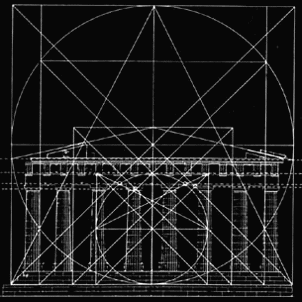 Taken From: Robert Lawlor's book Sacred Geometry; Philosophy and Practice, Thames and Hudson, 1982
Taken From: Robert Lawlor's book Sacred Geometry; Philosophy and Practice, Thames and Hudson, 1982Stepping out of ancient Egypt, we can look at the Parthenon, built be the ancient Greeks. As mentioned, the Greeks learned much of their knowledge of sacred architecture from the Egyptians, so it is no suprise that we find them employing the same set of proportions in their temples as well. The Parthenon was designed in such a way that it conveys several sacred geometric proportions, although the use of phi is particulary prominent in the proportions delineated by its facade. In particular, if the height of the structure from base to peak is taken to equal one, then the width of the structure across the facade measures exactly 1.618. As with Ramses temple, the placement of the pillars, and many other aspects of the building, are then determined by exponential factors of phi, such as one divided by phi over two, three, etc.
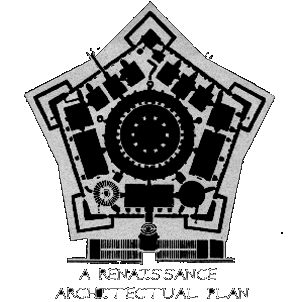 Taken From: Robert Lawlor's book Sacred Geometry; Philosophy and Practice, Thames and Hudson, 1982
Taken From: Robert Lawlor's book Sacred Geometry; Philosophy and Practice, Thames and Hudson, 1982Hundreds of years later, the Renaissance begain in Italy, circa the 14th century. During Medieval times, Europe lost much of the knowledge gained by the earlier Greek and Roman cultures, Europe as a whole suddenly took an interest in rediscovering the ancient knowledge that its predessors had assembled. As very little written material had survived the dark years in between the Renaissance and the fall of Rome, those interested in the ancient cultures turned to studying the ruins and relics that they had left behind. It was not long before sacred geometry was back as a central theme in architecture, as the architectural plan at left shows quite clearly.
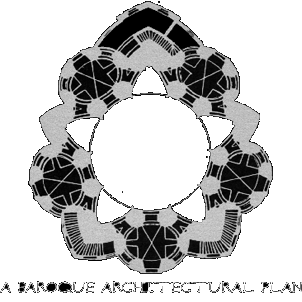 Taken From: Robert Lawlor's book Sacred Geometry; Philosophy and Practice, Thames and Hudson, 1982
Taken From: Robert Lawlor's book Sacred Geometry; Philosophy and Practice, Thames and Hudson, 1982Here we have a somewhat later example of an architectural style known as the Baroque style. Baroque flourished in the 17th century, and is known for its highly complex and irregular forms. As can be seen in our example at left, however, the core usage of pentagonal symmetry was still widely used - it was simply made slightly irregular to make its use not as obvious.

Finally, we present this piece of Islamic calligraphy art, which is not directly based on the proportions of phi at all, but instead conveys the meaning of phi quite directly through its simple, yet poetic, meaning:
"Verily we belong to God and to Him do we return..."


